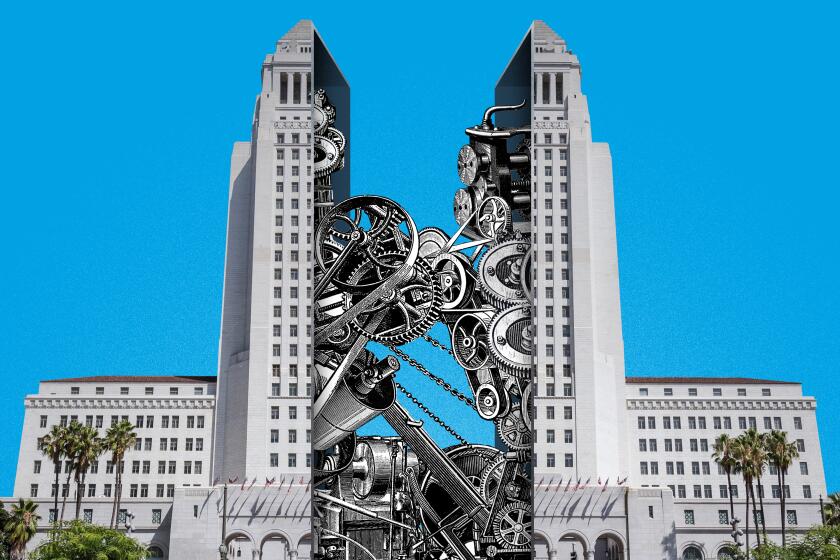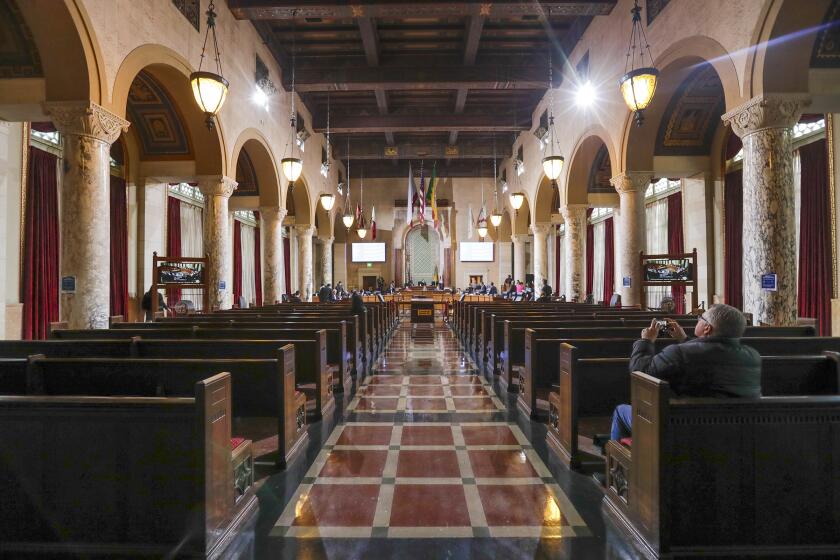Los Angeles needs a bigger City Council. Here are three ways to get it

- Share via
Los Angeles needs a bigger City Council. Fifteen council members are not enough to adequately represent the ethnic, geographic and socioeconomic diversity of 4 million residents. Too many Angelenos feel detached from their city government, ignored or unheard, and that weakens public trust, civic participation and, ultimately, democracy.
Proposals to expand the council have gotten little traction since 1999 when voters rejected two competing ballot measures to increase the council to 21 or 25 members. But now, after a cavalcade of scandal, there is new momentum for reforming City Hall that may convince voters to finally embrace the idea that bigger is better.
Next month, the City Council’s Ad Hoc Committee on City Governance Reform will begin debating whether to put a measure on the ballot in 2024 to expand the City Council, and if so, how big and how bold that expansion should be. Let’s be clear: Los Angeles voters should absolutely be asked to expand the council. This is an essential and overdue reform.
Fixing City Hall
Los Angeles City Hall has been rocked by scandal after scandal, but now there’s momentum to reform city government.
The editorial board looked at three possible changes that have been floated in recent months, ranging from moderate, major and radical. All of these ideas have their pluses and minuses — as we spell out below. They are all better than the status quo and worthy of consideration.
A simple City Council expansion
It’s a sign of how far the reform movement has come that this “moderate” change would have been considered radical a year ago, when almost no one in City Hall was seriously considering expanding the council.
Nevertheless, we call it moderate because the most straightforward expansion would just add more districts. Los Angeles’ 15 districts each include roughly 260,000 residents — the largest by population in the country. More districts means adding council members who would represent fewer people, providing constituents more localized attention and likely increase ethnic, religious and socioeconomic representation on the council.
How many districts is the harder question.
We asked Los Angeles’ elected leaders and candidates if they would support putting a measure on the ballot to enlarge the City Council.
Some groups argue L.A. shouldn’t pick a number, but rather set the ideal level of representation. California Common Cause, a good-government advocacy organization, has urged the city to create 150,000-resident districts — the equivalent of 27 districts based on current population — and allow the number of districts to rise or fall every 10 years with population changes. This idea has caused some heartburn in City Hall because it would create political upheaval every decade.
Instead, most City Hall insiders and observers are debating a set number of seats. One such proposal would add four new districts, with the 19 council members each representing about 209,000 residents, which would still leave L.A. with the largest districts in the nation. Such a small adjustment would hardly be noticeable and wouldn’t change much about how the council operates; perhaps that’s why some council members seem most amenable to this kind of modest change. But it’s not worth the trouble. L.A. should go bigger.
Given the city’s population, it would take 23 districts to be on par with New York City’s 173,000 residents-to-representative ratio. At 25, L.A. would be close to San Diego’s 154,000 residents per district. And 31 (an odd number is needed to avoid tie votes) would put L.A. among the average of large cities with 128,000 residents per district, according to Fair Rep LA, a reform coalition formed after L.A.’s flawed 2021 redistricting.
Doubling or even tripling the number of districts to a Chicago-size council of 50 members, as some have suggested, would change the nature of the City Council, which now operates like 15 mini mayors, each running their own district. Individual members on a very large council would have less power and would likely be led by a strong council president “because somebody has to run that large, inefficient, herding-of-the-cats operation,” current Council President Paul Krekorian observed, not fondly.
Los Angeles has the biggest council districts in the nation. Voters need to add seats to the 15-member council to increase representation and accountability.
Expanding the council won’t end political corruption if members are still allowed to treat their districts as fiefdoms in which they control development and real estate approvals. So any meaningful reform package would also curtail council members’ power to make land-use decisions in their districts.
A hybrid system, with at-large and district council members
Another idea comes from a group of political science scholars who argue a hybrid system — a major change in the council’s composition — could address concerns that the current setup is too provincial and doesn’t adequately represent the broad and varied interests of residents.
The LA Governance Reform Project proposes expanding the City Council to 25 members but with a twist. It would include 21 districts, each with an elected council member, and four at-large members elected citywide. The scholars argue a hybrid system is the best compromise; it addresses the need for smaller districts with localized representation and it includes voting members to balance the provincialism with a citywide perspective.
One of the complaints about L.A. government is that everything, whether budget, services or public policy, is divided by 15. Lacking is a citywide approach to issues such as housing, homelessness and transportation, instead allowing council members to decide whether bus-only lanes or homeless shelters are built in their districts. At-large council members would have a mandate to think beyond localized interests and might campaign on broader issues such renters’ rights, bike lanes or reforming the business climate. The change could also be a check on corruption; at-large candidates might be less inclined to support the culture of deference to council members on land-use and development decisions in their districts.
Los Angeles City Hall’s dysfunctional relationship with real estate development has contributed to so many of the city’s ills.
A hybrid system has some potential pitfalls, warned Kathay Feng with Common Cause. The California Voting Rights Act forced many cities to switch from at-large to district elections so minority or underrepresented groups would have a chance to elect a representative of their choice. Running for citywide office is so expensive that at-large seats could be dominated by well-funded, politically connected candidates. Some cities have adopted hybrid systems knowing the at-large seats could protect the power of incumbents and their allies and dilute the influence of communities of color.
“I do think you can have a mixed system if the at-large seats are coupled with methods of casting ballots that give minority communities an ability to vote with greater voter representation,” such as ranked-choice voting, Feng added.
A radical overhaul of the district system
Some advocates want L.A. to consider a more radical change such as the recent voter-approved change in Portland, Ore., to elect three council members per district using ranked-choice voting.
While several states, including Arizona, New Jersey, South Dakota and Washington, elect more than one representative per district to their legislature, multi-member districts are rare in American cities. Which is why Portland’s decision is so unusual.
Portland is phasing out its system of five council members elected at-large to manage city departments, including parks, police and sanitation, in which they may have no expertise. Critics said the system was ineffective and failing residents. Plus, most of the elected officials came from the wealthy westside of the city.
But simply switching to a district system that elects a single council member would have disenfranchised communities of color, which make up one-quarter of Portland’s population and are dispersed throughout the city. There was no way to draw districts that would allow the city’s Black, Asian or Latino voters to elect a representative of their choice.
The expectation is that this system will give traditionally marginalized groups — renters, young people, the working class — a better shot at gaining a seat than in a winner-take-all election. Advocates also hope it will improve service because constituents can call three representatives in City Hall when they need a response, not just one.
But this is still an untested system for Portland, and there are concerns that multi-member districts may create a lack of accountability where nobody is in charge.
That hasn’t stopped advocates from urging the L.A. City Council to look at the Portland model as an answer to the zero-sum politics of redistricting and elections in Los Angeles, when Black, Latino and Asian are seen in competition against one another in a winner-take-all council race.
And it wouldn’t be the first time California’s neighbor to the north led the way on election reform. “Oregon instituted vote-by-mail. We were the first ones to do it and people said it would be a disaster. It’s worked beautifully,” said Melanie Billings-Yun, who co-chaired Portland’s Charter Commission. “We were the first to institute automatic voter registration. We have never shied from being innovators and we’ve rarely regretted it.”
This is an exciting moment for Los Angeles, with new ideas and real potential for change. We hope city leaders consider all these council expansion options and others, with open minds and a willingness to be bold in fixing City Hall.
More to Read
A cure for the common opinion
Get thought-provoking perspectives with our weekly newsletter.
You may occasionally receive promotional content from the Los Angeles Times.













